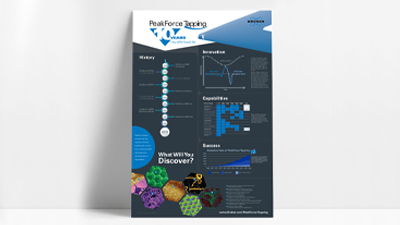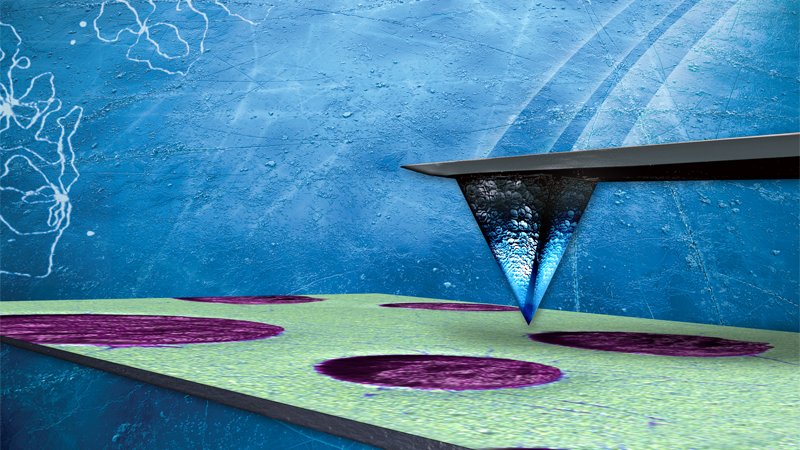PeakForce Tapping
Bruker’s exclusive PeakForce Tapping® has been the most significant scientific breakthrough in atomic force microscope (AFM) technology since the introduction of TappingMode™. It provides unprecedented high-resolution imaging, extends AFM measurements into a range of samples not previously accessed and uniquely enables simultaneous nanoscale property mapping. And now, new ScanAsyst® Plus self-optimizing imaging software comes standard with select NanoScope® 6 systems, bringing expanded capability and ease of use to PeakForce Tapping measurements.
PeakForce Tapping — How AFM Should Be, 10 Years and Counting
Highest Resolution Imaging
PeakForce Tapping enables the researcher to precisely control probe-to-sample interaction enabling the lowest available imaging forces. This superior force control results in the most consistent, highest resolution AFM imaging for the widest range of sample types, from the softest biological samples to very hard materials.
Unique, Quantitative Results, Whatever You Measure
PeakForce Tapping’s piconewton (pN) force sensitivity simultaneously and uniquely combines the highest resolution AFM imaging with quantitative, nanoscale electrical, mechanical, biological, and chemical property mapping, enabling researchers of all experience levels to make new discoveries.
Easy to Use, Making Every User an AFM Expert
PeakForce Tapping’s direct and linear force control provides the user with unmatched AFM ease of use with ScanAsyst® image optimization software, and the low forces preserve the probe shape for longer life and more consistent imaging.
How It Works
In PeakForce Tapping, the probe periodically taps the sample and the pN-level interaction force is measured directly by the deflection of the cantilever. A real feedback loop (not force trigger) keeps the peak force down to 10 pN at actuation rates up to 8 kHz, in air and fluid.
PeakForce Tapping is ideal for both materials research and biological samples due to its unprecedented low imaging forces and ease of use. No cantilever tuning is necessary. The superior force control maintains tip and sample integrity, leading to consistently accurate and high-resolution measurements of even the smallest structures, from atomic defects to double helix DNA.
PeakForce Tapping Enabled AFM Modes
The greatest power of PeakForce Tapping technology comes from its ability to simultaneously enable and enhance other correlative and quantitative mapping techniques, delivering new possibilities in an ever-expanding set of topographical, mechanical, biological, electrical and chemical applications at the nanoscale:
- PeakForce QNM® - Quantitative Nanoscale Mechanical Characterization
- PeakForce TUNA® - Highest Resolution Current Mapping on the Most Fragile Samples
- PeakForce Kelvin Probe Force Microscopy - Industry-Leading Spatial Resolution and Artifact-Free Contrast
- PeakForce Capture - High-Sensitivity Nanomechanical Data at Every Pixel
- PeakForce SECM - AFM-Based Scanning Electrochemical Microscopy
- PeakForce sMIM - Most Sensitive and Complete Nanoscale Mapping of Permittivity and Conductivity
Greatest Adoption Rate of Any AFM Mode
The adoption rate of PeakForce Tapping has surpassed even that of TappingMode, with over 4,000 publications in the ten years since its release. This includes over 2000 publications using PeakForce QNM and more than 400 using PeakForce electrical modes. That is more than one PeakForce Tapping article every day, for 10 years!
PeakForce Tapping provided my lab with the force control and resolution necessary to produce ground-breaking ligand-receptor interaction maps using functionalized probes on live cells in a very time efficient and controlled way.
Dr. Daniel Müller, ETH Zürich, Switzerland



